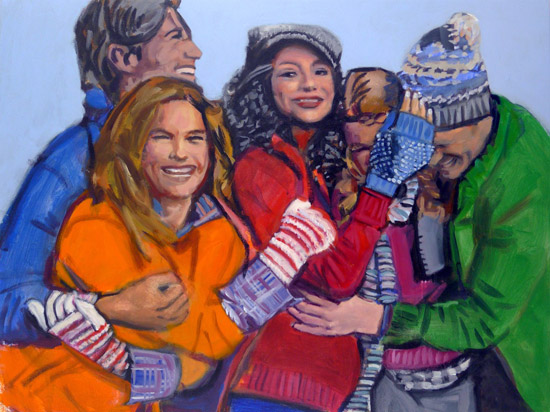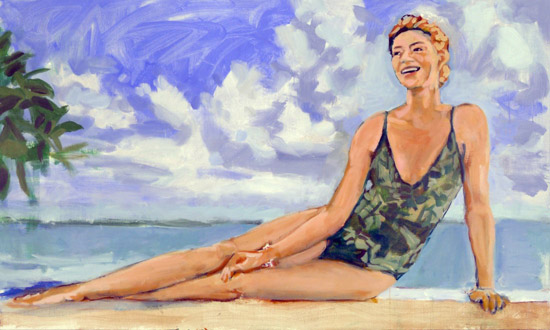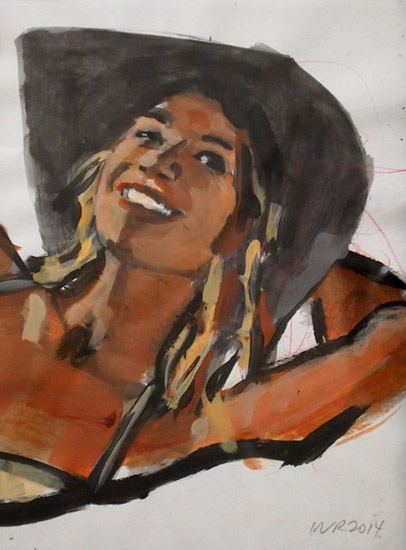Walter Robinson is having a blast. He’s painting cheery figures with Colgate grins, back-slapping guys’ camaraderie, sexy nurses, sumptuous burgers-of-the-week, beach girls in come-hither poses, piles of chocolate cookies, and stacks of pancakes with syrup and butter. A bacchanal of bright colors, easy sex, and mouth-watering delight. Everything anyone could desire.
And that is his subject: Desire, and how we acquired it. The results can be found in his solo show "Walter Robinson / Figure Studies" at Lynch Tham on the Lower East Side of New York City.
.

"Friendly’ s Big Beef Burger" by Walter Robinson, 2012. Acrylic on canvas,16 x 19 inches.
.
Robinson is solidly within the Pictures Generation, artists who were born in the ’40s and ’50s, the first generation raised on television and pop media that supplanted the declining narratives of organized religion. The bookends for this generation are two shows three decades apart. The first, entitled “Pictures,” was at Artists Space in 1977. The second was at the imposing Metropolitan Museum of Art in 2009, bearing the title “The Pictures Generation, 1974-1984.”
The first show was a smallish downtown affair with but five artists: Jack Goldstein, Sherry Levine, Robert Longo, Troy Brauntuch and Philip Smith. Cindy Sherman, whose work was installed elsewhere in the building, would later be included in this crowd. The show might have passed unnoticed, and the artists but footnotes to the blank images of Andy Warhol, if it wasn’t for the catalog essay by the show’s curator Douglas Crimp. Crimp described an artistic inversion wherein we were not drawing pictures, instead the pictures were drawing us.
Pictures being used in this sense include images from all media, whether from art, television, kids’ toys, movies, and especially from advertising, a daily tsunami that floods our consciousness with perfect objects and situations we need to acquire. Many of these images are repeated here in the paintings of Robinson. Our desire did not spring from within, Crimp reasoned, but instead was being planted by others.
The essay had legs, as they say.
.

"Lands’ End Friends and Family" by Walter Robinson, 2014. Acrylic on canvas, 30 x 40 inches.
.
The Pictures Generation was canonized in a surprisingly hip 2009 offering by the dusty Metropolitan Museum of Art, which mounted a 30-person show of those who joined the original five, with 160 works and a large catalog.
Crimp’s ideas were timely, but not new. Indeed vaudeville star Will Rogers had a 1930s routine selling a wizard’s potion called “advertising” to a king. The king asks, “Is it a powerful potion?” “Indeed,” exclaims Rogers, “It will make you spend money you don’t have for things you don’t need!” The King coos with excitement.
The renewed interest in advertising’s leaden foot by the Pictures Generation stemmed from the idea that our desire and activities were being guided by the myriad images, or pictures, among which we lived. This conclusion dovetailed perfectly with thinking happening elsewhere in continental philosophy and ultimately the two schools of thought merged into a perfect storm of nihilism that validated and sustained this group of artists.
.
.
In philosophy it was the centering of the individual ego as a timeless episteme, and its use as a reference—an inverted Platonism if you will—that was sacred in phenomenology and in its expression in modern art. It became the target for an extensive century-long dismantling that endeavored to disembody this idea of self by everyone from Karl Marx to Sigmund Freud and later after-structuralist writers like Michel Foucault and Jacques Derrida.
They had a common plan: demonstrate that selfhood—a difficult but handy word—was contingent upon event, especially the impact of text and images. It was the avowed aim of this structural philosophy to show that an individual's ego, one's selfhood, bore the stamp of personal history as well as the history of the society. These writings appeared while the art world still cherished the intact and talented psyche that produced abstract expressionism, action art, and finally minimalism.
The art world crossover was French philosopher Roland Barthes’s 1967 essay “Death of the Author,” which put forward ideas that quickly pushed into the visual world. Barthes believed writers were unknowingly collecting and recycling quotations and images; assembling rather than creating despite their desire to be original. The techniques he and others developed to tease apart these inherited layers were surprisingly pragmatic and difficult to deny.
It was an influential essay that left artists and writers poised like Descartes, slumped over his desk, staring at his hands wondering if there was a way he could be sure they were his. Impossibly, the situation worsened: after the sovereign self was riddled by decades of structural exegesis, the Pictures Generation moved in and shot the corpse, showing the formative processes to be utterly chaotic and purposeless.
Run-out French nihilist philosophy dressed up in American pop art; the party lasted for decades.
Walter Robinson’s role, until recently, was to provide the words. He was the editor of Art-Rite Magazine and The Art Letter, news editor for Art In America and founding editor of Artnet Magazine, a position he held for 16 years. Artnet shuttered in 2012 and since then Robinson has been painting up a storm, with serial shows in major Manhattan galleries. At 64, his star is ascendant.
Robinson’s current show at Lynch Tham is full of the healthy faces and cheerful colors that populate the ad world. He is taking inventory of the desire he feels and tossing it up on the wall all at once. It’s nothing if not likeable.
“Land’s End Swimming in Confidence” is white girl perfection, leggy, content, modest yet inviting, a swimwear ad that Robinson upgraded to acrylic on linen. Several other paintings are lifted from the Land’s End motherlode, including a series of plaid shirt paintings. Yuck, he’s desiring those? Terry Richardson’s frock?
.

"Lands’ End Swimming in Confidence" by Walter Robinson, 2014. Acrylic on linen, 36 x 60 inches.
.
“Land’s End Odalisque” is another dead on painting, a Hamptons beach scene of a 20-something blond girl with a “what are we doing later” smile and a coy hat. This is a representation of the universal desire of straight men that Robinson sees as an update of the 1814 “Grand Odalisque” of Jean Ingres that hangs in the Louvre.
.

"Untitled (Lands’ End Odalisque)" by Walter Robinson, 2014. Acrylic on paper, 12 x 9 inches.
.
I chuckled that the word-salad press release had slipped by the ne plus ultra of arts editors; in a way it underlines that he has retired from that guiding role and is now expanding his painting career with force and good cheer. Walter Robinson is having a blast.
.

Walter Robinson.
.
BASIC FACTS: "Walter Robinson / Figure Studies" is on view from May 28 to July 13, 2014 at Lynch Tham, 175 Rivington Street, New York, NY 10002. www.lynchtham.com. The gallery is open Wednesday through Saturday, 10 a.m. to 6 p.m.; Sunday, noon to 6 p.m.; and by appointment on Monday and Tuesday.
_________________________
Copyright 2014 Hamptons Art Hub LLC. All rights reserved.

